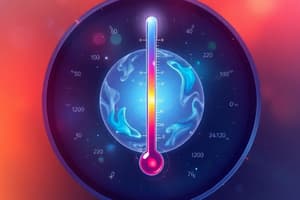Podcast
Questions and Answers
What is the temperature scale often used in chemistry?
What is the temperature scale often used in chemistry?
- Absolute zero scale
- Fahrenheit scale
- Centigrade scale
- Kelvin scale (correct)
Which temperature scale sets water's freezing point at 0 degrees?
Which temperature scale sets water's freezing point at 0 degrees?
- Absolute zero scale
- Fahrenheit scale
- Kelvin scale
- Celsius scale (correct)
What is the zero point of the Kelvin scale called?
What is the zero point of the Kelvin scale called?
- Absolute zero (correct)
- Freezing point
- Boiling point
- Melting point
How many scales of temperature are currently in use according to the text?
How many scales of temperature are currently in use according to the text?
Which scientist devised the Fahrenheit scale?
Which scientist devised the Fahrenheit scale?
What is the temperature at which all motion of particles ceases?
What is the temperature at which all motion of particles ceases?
What is the correct way to express 35,000 meters in scientific notation?
What is the correct way to express 35,000 meters in scientific notation?
What is the number of significant figures in 0.0025 kg?
What is the number of significant figures in 0.0025 kg?
If the temperature is 77°F, what is its value in degrees Celsius?
If the temperature is 77°F, what is its value in degrees Celsius?
What is the freezing point of water in Kelvin?
What is the freezing point of water in Kelvin?
If the temperature is 50°C, what is its value in Kelvin?
If the temperature is 50°C, what is its value in Kelvin?
Which prefix is used to represent 10^-12 in the SI system?
Which prefix is used to represent 10^-12 in the SI system?
What temperature does water boil at on the Fahrenheit scale?
What temperature does water boil at on the Fahrenheit scale?
In scientific notation, how would you write 0.0006 m?
In scientific notation, how would you write 0.0006 m?
What is the freezing point of water in Kelvin?
What is the freezing point of water in Kelvin?
What is absolute zero in Celsius?
What is absolute zero in Celsius?
How do you convert Fahrenheit to Celsius?
How do you convert Fahrenheit to Celsius?
If a number is written in the form a x 10^b in scientific notation, what does 'a' represent?
If a number is written in the form a x 10^b in scientific notation, what does 'a' represent?
Flashcards
Kelvin scale
Kelvin scale
A temperature scale used in chemistry, where zero represents absolute zero.
Celsius scale
Celsius scale
A temperature scale where water freezes at 0°C.
Absolute zero
Absolute zero
The zero point on the Kelvin scale, representing the absence of thermal energy.
3 temperature scales
3 temperature scales
Signup and view all the flashcards
Fahrenheit scale
Fahrenheit scale
Signup and view all the flashcards
All particle motion ceases
All particle motion ceases
Signup and view all the flashcards
3.5 x 10^4 m
3.5 x 10^4 m
Signup and view all the flashcards
Significant figures
Significant figures
Signup and view all the flashcards
0.0025 kg
0.0025 kg
Signup and view all the flashcards
77°F to Celsius
77°F to Celsius
Signup and view all the flashcards
Water's freezing point (Kelvin)
Water's freezing point (Kelvin)
Signup and view all the flashcards
50°C to Kelvin
50°C to Kelvin
Signup and view all the flashcards
Pico (p)
Pico (p)
Signup and view all the flashcards
Water's boiling point (Fahrenheit)
Water's boiling point (Fahrenheit)
Signup and view all the flashcards
0.0006 m (scientific notation)
0.0006 m (scientific notation)
Signup and view all the flashcards
Water's freezing point (Kelvin) 2
Water's freezing point (Kelvin) 2
Signup and view all the flashcards
Absolute zero (Celsius)
Absolute zero (Celsius)
Signup and view all the flashcards
Fahrenheit to Celsius conversion
Fahrenheit to Celsius conversion
Signup and view all the flashcards
Scientific notation 'a'
Scientific notation 'a'
Signup and view all the flashcards
Study Notes
Temperature
- Temperature is a property of matter that determines the direction of heat transfer.
- It is frequently measured quantity in chemistry, and is the measure of how hot or cold one object is relative to another.
Temperature Scales
- There are three temperature scales in use: Fahrenheit, Celsius, and Kelvin.
- The Celsius scale is also known as the Centigrade scale.
- The Kelvin scale is the SI scale used to measure temperature, with its zero point being absolute zero (-273°C).
- Absolute zero is the temperature at which all motion of the particles of matter ceases.
Converting Between Temperature Scales
- Celsius to Kelvin: K = °C + 273
- Kelvin to Celsius: °C = K - 273
- Fahrenheit to Celsius: °C = 5/9(°F - 32)
- Celsius to Fahrenheit: °F = 9/5°C + 32
Measurement Systems
- The Metric System is a decimal system of measurement, with the SI system being a specific metric system.
- The SI system has seven base units: kilogram (kg), second (s), meter (m), ampere (A), candela (cd), and mole (mol).
- The International System of Units (SI) is adopted worldwide and is simple and convenient to use since all units are based on multiples of 10.
- The English System, also known as the British or Imperial system, uses units such as yard, ounce, and pound.
Scientific Notation
- Scientific notation is a standard way of writing very large and very small numbers.
- Examples: 0.0005 m = 5 x 10^-4 m, 1,200,000 s = 1.2 x 10^6 s.
- To write in scientific notation, follow the form: a x 10^b, where a is a number between 1 and 9, and b is the positive or negative exponent.
Studying That Suits You
Use AI to generate personalized quizzes and flashcards to suit your learning preferences.




